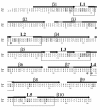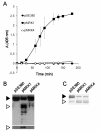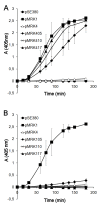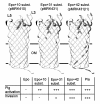Molecular adaptation of a plant-bacterium outer membrane protease towards plague virulence factor Pla
- PMID: 21310089
- PMCID: PMC3048539
- DOI: 10.1186/1471-2148-11-43
Molecular adaptation of a plant-bacterium outer membrane protease towards plague virulence factor Pla
Abstract
Background: Omptins are a family of outer membrane proteases that have spread by horizontal gene transfer in Gram-negative bacteria that infect vertebrates or plants. Despite structural similarity, the molecular functions of omptins differ in a manner that reflects the life style of their host bacteria. To simulate the molecular adaptation of omptins, we applied site-specific mutagenesis to make Epo of the plant pathogenic Erwinia pyrifoliae exhibit virulence-associated functions of its close homolog, the plasminogen activator Pla of Yersinia pestis. We addressed three virulence-associated functions exhibited by Pla, i.e., proteolytic activation of plasminogen, proteolytic degradation of serine protease inhibitors, and invasion into human cells.
Results: Pla and Epo expressed in Escherichia coli are both functional endopeptidases and cleave human serine protease inhibitors, but Epo failed to activate plasminogen and to mediate invasion into a human endothelial-like cell line. Swapping of ten amino acid residues at two surface loops of Pla and Epo introduced plasminogen activation capacity in Epo and inactivated the function in Pla. We also compared the structure of Pla and the modeled structure of Epo to analyze the structural variations that could rationalize the different proteolytic activities. Epo-expressing bacteria managed to invade human cells only after all extramembranous residues that differ between Pla and Epo and the first transmembrane β-strand had been changed.
Conclusions: We describe molecular adaptation of a protease from an environmental setting towards a virulence factor detrimental for humans. Our results stress the evolvability of bacterial β-barrel surface structures and the environment as a source of progenitor virulence molecules of human pathogens.
Figures







References
-
- Pallen MJ, Nelson KE, Preston GM. Bacterial pathogenomics. Washington, DC, USA: ASM Press; 2007.
-
- Seifert HS, Dirita VJ. Evolution of microbial pathogens. Washington, DC, USA: ASM Press; 2006.
Publication types
MeSH terms
Substances
LinkOut - more resources
Full Text Sources
Research Materials

